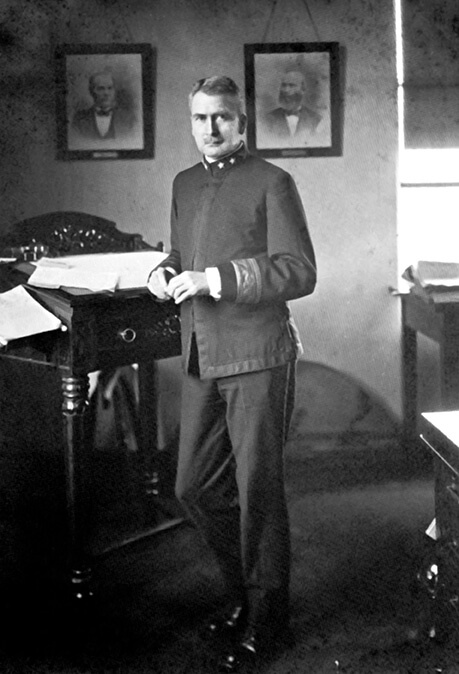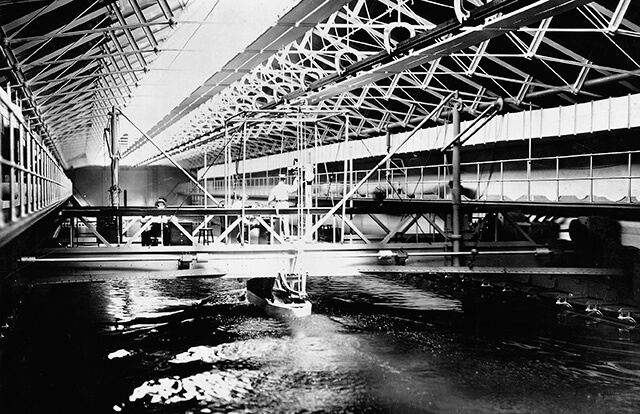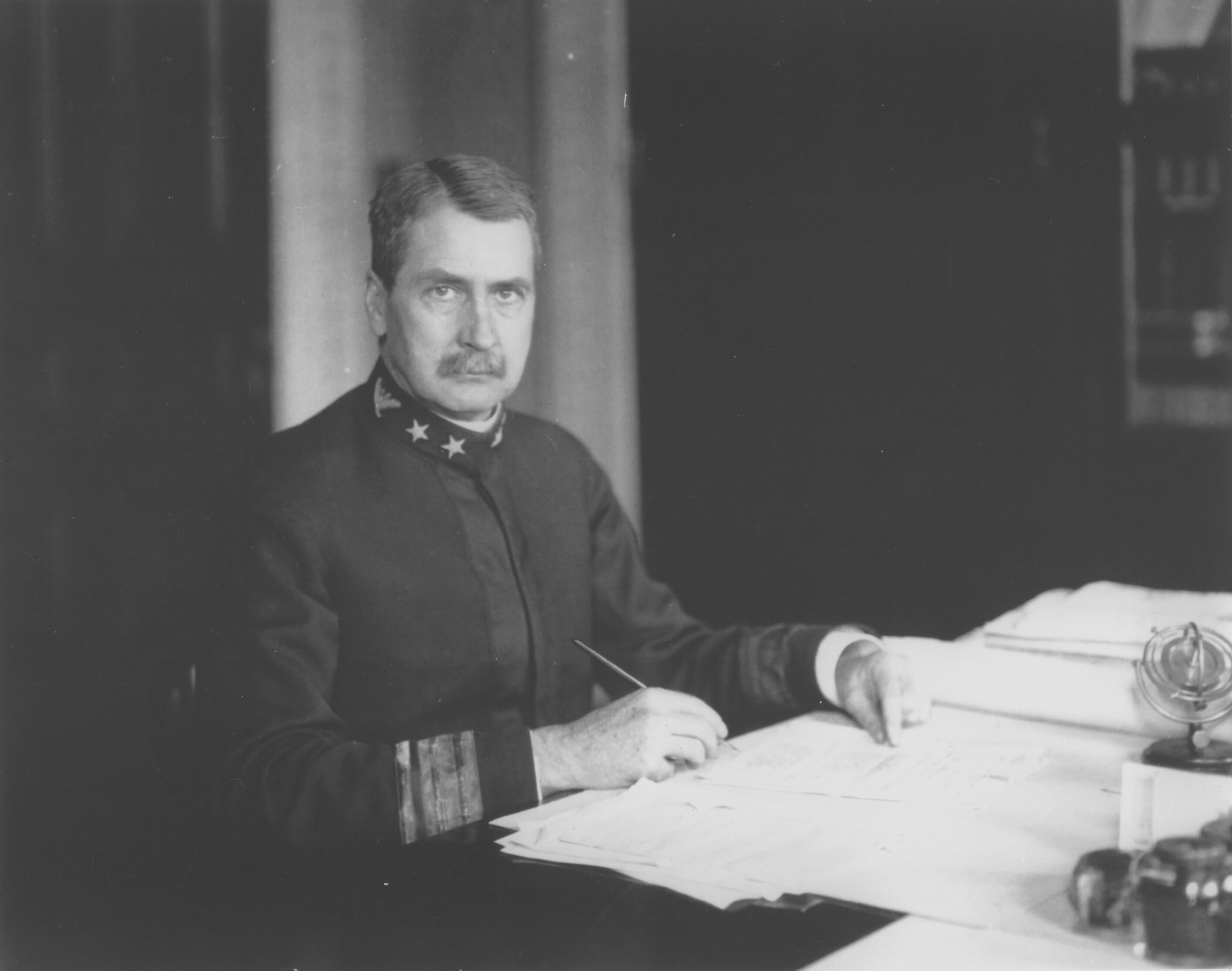- David Watson Taylor was born on March 4, 1864, in Louisa County, Virginia.
- He entered the United States Naval Academy in 1881, after graduating from Randolph Macon College, where he was a member of Phi Kappa Psi
- He graduated from the Academy in 1885 at the head of his class, setting a scholarship record.
- In 1885, he was sent to Greenwich, England, and received the highest honors of the Royal Naval College in 1888, again setting a record.
- He was the first American honored by the award of a Gold Medal of the British Institute of Naval Architecture.
- In 1939, shortly before his death, the Navy honored Taylor by naming its new model basin at Carderock, Maryland, after him; the dedication was made in his presence.
 Rear Admiral David W. Taylor (1864 - 1940) served in the United States Navy during World War I as Chief Constructor and Chief of the Bureau of Construction and Repair, and is best known for constructing the first experimental towing tank ever built in the United States. Long recognized as an international authority on naval architecture and marine engineering, Taylor practically applied the principles of hydrodynamics to the problem of aerodynamics. Following this new field of aviation, he also became one of the foremost authorities in the world on aerodynamics. He specialized on problems connected with the design of aircraft propellers and of seaplane floats and flying-boat hulls.
Rear Admiral David W. Taylor (1864 - 1940) served in the United States Navy during World War I as Chief Constructor and Chief of the Bureau of Construction and Repair, and is best known for constructing the first experimental towing tank ever built in the United States. Long recognized as an international authority on naval architecture and marine engineering, Taylor practically applied the principles of hydrodynamics to the problem of aerodynamics. Following this new field of aviation, he also became one of the foremost authorities in the world on aerodynamics. He specialized on problems connected with the design of aircraft propellers and of seaplane floats and flying-boat hulls.
Taylor began his naval career in 1885, and was soon thereafter appointed as an assistant naval constructor. He served on various stations, and in 1898, he constructed and had charge of the first experimental tank for models of war vessels built in the United States. He was connected with boards dealing with hill changes of naval vessels.
In 1910, he created the Taylor Standard Series Method of shipbuilding, which is considered the greatest achievement of his career. He built 80 models that allowed variation of the slenderness ratio, beam to draft ratio, and prismatic coefficient. Taylor’s main contribution was to recognize that these three simple parameters were the critical ones for ship performance. A Taylor Series estimate is accurate enough to plan the model test and to develop an idea of how much power will be required to achieve design speed, prior to model testing the actual hull form. While these are far from the only parameters that can be varied in a warship’s hull design, it is possible to get a preliminary estimate of the ship resistance from the series for essentially all warships and many merchant ships built since Taylor’s time.
 After the RMS Titanic disaster of 1912, Taylor was assigned to investigate the problem of making ships more seaworthy through better hull construction. On this duty, he served under the Secretary of Commerce and took a leading part in the International Conference on Safety at Sea, which grew out of the Titanic sinking.
After the RMS Titanic disaster of 1912, Taylor was assigned to investigate the problem of making ships more seaworthy through better hull construction. On this duty, he served under the Secretary of Commerce and took a leading part in the International Conference on Safety at Sea, which grew out of the Titanic sinking.
On December 14, 1914, a few months after the outbreak of World War I in Europe, Taylor became Chief of the Bureau of Construction and Repair, attaining the rank of Rear Admiral. He held that post throughout the war, along with the title Chief Constructor of the Navy. Throughout the war, Taylor supervised the creation of numbers of new ships for naval service. For this work, the Navy bestowed upon him the Distinguished Service Medal, with the citation: “For exceptionally meritorious service in a duty of great responsibility.”
 Taylor’s active interest in aviation was stimulated by his appointment as a representative of the government on the National Research Council in 1916. In January 1917, he was a senior member of the Joint Army and Navy Technical Board for Design and Construction of a Zeppelin-type airship. He also aided in the development of the NC-type flying boat, the first aircraft to make a transatlantic flight.
Taylor’s active interest in aviation was stimulated by his appointment as a representative of the government on the National Research Council in 1916. In January 1917, he was a senior member of the Joint Army and Navy Technical Board for Design and Construction of a Zeppelin-type airship. He also aided in the development of the NC-type flying boat, the first aircraft to make a transatlantic flight.
After his retirement from active duty, Taylor focused his attention exclusively on aeronautics. He played a major role in promoting aviation’s technical development, serving on several committees of the National Advisory Committee for Aeronuatics (NACA), the precursor of the National Aeronautics and Space Administration (NASA). When NACA’s Subcommittee on Aeronautical Inventions and Designs was organized in March 1927, Taylor served as Chairman, and later that year, he was made Chairman of the Subcommittee on Aerodynamics.
Taylor was awarded many prestigious honors during his lifetime. Perhaps the most prestigious was the John Fritz Medal, the highest honor of the American engineering profession, which he was awarded in 1931, “for outstanding achievement in marine architecture, for revolutionary results of persistent research in hull design, for improvements in many types of warships and for distinguished service as chief constructor for the United States Navy during the World War.” In 1942, the destroyer David W. Taylor was named for him, and the Navy’s “David W. Taylor” Award recognizes his outstanding scientific achievement towards his contributions to the development of future maritime systems.
Use of Standard Series Results. In addition to the comparatively simple methods of powering ships described there have been many others proposed which are as a rule more complicated. Many involved for mulas for resistance have been brought forward from time to time.
Skin resistance is readily estimated by a formula using the coefficients of Froude and Tideman, but no general formula giving residuary resistance accurately for any wide range of speed, proportions, and fullness of model has yet been brought forward. We have seen that the best approximate methods of powering hith erto used are all weak in leaving largely to the skill and judgment of the designer, to his guesswork, the effect of proportions and fullness of model, and that in order to make satisfactory guesses the designer must have an accumulation of data possessed by few.
Now by the use of the data given in Figures 188 to 240 it is possible to estimate with great accuracy the effective horsepower of a ship of any displacement, dimensions, and longitudinal coefficient upon the lines of the Standard Series. Furthermore, such a curve of effective horsepower will approximate fairly closely the EHP of models upon different lines. For with displacement, length, midship section area, and longitudinal coefficient fixed, any variations in shape that would be made in good practice will have a compara tively minor effect upon resistance. Hence, with the aid of the Standard Series the problem of powering a ship is solved in two steps.
First: From the Standard Series results get out a curve of EHP for a ship of the same displacement, length, beam-draft ratio and longitudinal coefficient.
Second: From the EHP estimate Pi or Ps by applying a suitable coefficient of propulsion.
When following this method there are two principal sources of error.
First, there is the possibility that the lines used may differ so much from those of the Standard Series that the estimated EHP may be materially in error. This source of error may be avoided by closely follow ing the lines of the Standard Series unless lines positively known to be superior are available. It should be kept in mind, also, that the values of the Standard Series were derived from models towed in bare hull condition; i. e., without rudder, bilge keels, or other appendages.
Second, the coefficient of propulsion chosen may be in error. This is an unavoidable source of error, and it is on this point only that the designer, when using the Standard Series method, must use some guesswork.
_in_Mobile_Bay_in_September_1943.jpg)
The USS David W. Taylor underway.
Additional Resources